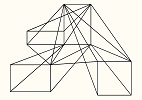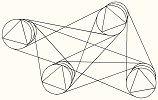


 |
 |  |
How Physicists Got Global Warming Wrong and Almost Everything Else They Did Since 1845 It was corruption of physics, developed over more than a century, which resulted in social fantasies related to global warming, renewable energy, electric vehicles and self-driving. The first evidence of a problem in physics showed up in 1686, when Gottfried Wilhelm von Leibniz suggested the false definition of kinetic energy. He published a paper titled: "A Brief Demonstration of the Memorable Error of Descartes and Others Concerning the Natural Law According to Which They Claim That the Same Quantity of Motion Is Always Conserved by God, a Law That They Use Incorrectly in Mechanical Problems."The snarkiness of the title says Leibniz assumed he could not possibly be wrong. But he was wrong. His error was not in his numbers; it was in the wrong starting point. The purpose was to determine the conserved quantity of motion, which is now called kinetic energy. Force and motion were being studied on pendulums, and it was found that both mass times velocity (mv) and mass times velocity squared (mv²) were conserved quantities during elastic collisions. Conserved means the same amount is found after an event as before. The question was, what is conserved beyond elastic collisions. The test is to rearrange the component elements and see which produce the same totals, which is what Leibniz did. He found that he could rearrange the components of force times distance and always maintain the same amount of mass times velocity squared.
There isn't any question that force times distance is proportional to mass times velocity squared. It's an irrelevant question. It doesn't mean either one is kinetic energy. A more complex energy analysis is needed to determine what energy is. Leibniz's error was in assuming that a combination of force times distance should be the starting point. What Leibniz missed is that he could have started with force times time and always conserved mass times velocity unsquared. His analysis didn't tell him which starting premise to use, and he chose the wrong alternative. In other words, a four kilogram object dropped for one second will produce the same amount of mass times velocity unsquared (mv, momentum) as a one kilogram object dropped for four seconds, which conserves mv (momentum). The issue was argued for 200 years and supposedly settled by James Joule in 1845 by stirring water in a wooden bucket to determine the amount of heat produced. Joule made claims of doing the impossible, such as taking care of environmental influences by doing an extra run, which showed that he contrived the result. But regardless, his experiment could not determine the correct definition of kinetic energy, because more than one point of measurement was needed and he only had one. Yet physicists pretend to this day to be verifying Joule's supposed proof of the definition of kinetic energy and improving the precision. The latest result says there are 4.1868 joules per calorie. (Indirect evidence indicates that there should be about 2 calories per joule, but the amount varies with conditions, since the definition of kinetic energy is wrong.) There is no indication of how physicists measure Joule's constant, which they now call "the mechanical equivalent of heat," but they appear to be referencing to electrical energy heating water. There is no absolute value reference for the amount of force (times distance) required to produce kinetic energy or a volt of electrical energy. So the quantitation of heat, electrical energy and kinetic energy floats at relative values rather than absolute values and does not have a proper relationship to other forms of energy such as the chemical energy of petroleum. There is a second reason why such experiments cannot determine the definition of kinetic energy. In measuring the force used to stir water, the difference between elastic force and inelastic force cannot be determined. Only the inelastic force creates heat, while elastic force creates linear stress on the container.
So the first "memorable" point to be made is that physicists got a lot wrong in their analysis regardless of the definition of energy. Not knowing that more than one point of measurement is needed is getting too much wrong for the trust that is placed in physicists. Clues to the misdefinition of energy show up wherever the equation is applied. The equation says kinetic energy equals one half mass times velocity squared (KE = ½mv²). Since nothing can move at velocity squared, the equation does not properly represent the motion of the mass. In 1983, I sent letters on this to several physics departments pointing out the contradictions in rockets. The Jet Propulsion Laboratory sent back the basic rocket equations saying the equations balance, so there is no problem. It's not relevant whether the equations balance, but having those equations, I could use rockets as a replacement for gravity in the Leibniz type analysis and mathematically prove what the proper equation for defining kinetic energy should be. The result showed that Leibniz was wrong and Descartes was right. Kinetic energy equals mass times velocity unsquared, which is now called momentum. Kinetic energy is the same thing as momentum, while ½mv² is nothing but a meaningless abstraction. My mathematical proof could be verified by a high school student who has studied physics and calculus. This error alone would corrupt about 90% of physics. But the very reason why the error exists is the reason why there has not been an iota of correct physics produced since Newton's laws, which were published in 1687. Physics is so abstract and hard to measure that physicists cannot meet the challenge. So they learned very early on to guess, contrive and round off corners. There is no actual science to physics. At most, some physicists are super engineers. There is no problem with engineering, as getting a functional result straightens out the procedures. Engineers use trial-and-error where the science leaves off until they get a functional result. This does not mean that the bubble chambers are not showing subatomic particles or the space telescopes are not observing actual phenomenon. It means the endless, incongruous physics applied to the subject matter is not science. Skipping over Planck's constant, which could not be right without a correct definition of energy, the Stefan-Boltzmann constant, which shows 20-50 times too much radiation given off by matter at normal temperatures and the Michelson-Morley experiment which produced no result and never showed that it could, the manner in which global warming was handled is every bit as shameless as Joule's experiment. Climatologists cannot explain a mechanism for global warming. Instead they use fake numbers, such as 3.7 watts per square meter to represent heat trapped in the atmosphere due to human activity. There are no square meters in the atmosphere. Climatologists convert the number into 1°C by reversing the Stefan-Boltzmann constant; but reversing that constant is not valid, because it only applies to surfaces. There is no mechanism for greenhouse gases creating global warming, because heat cannot be trapped in the atmosphere. Large amounts of heat move into and out of the atmosphere constantly, as temperatures change 20 degrees or more between day and night. Absorbed radiation is emitted in 83 femto seconds at an average wavelength of 25 microns, as all matter emits radiation constantly. The second law of thermodynamics says heat dissipates, all the time, everywhere, without exception. There cannot be a greenhouse effect in the atmosphere because of the second law of thermodynamics. Using terms such as "greenhouse effect" and "heat trapping gas" shows more ignorance by physicists. What greenhouses do is use glass or plastic to block air from moving. They keep out the weather with a physical barrier. The glass or plastic allows light to go through but not air currents. There is no such barrier in the atmosphere. So why use the term "greenhouse" for atmospheric effects? Adding the term "trapping" with it emphasizes the same point. Greenhouses trap air inside using glass or plastic. There is no barrier to trap anything in the atmosphere. The terms "greenhouse gas" and "heat trapping gas" are not analogies to anything that happens in the atmosphere. So why use such terms? A lot of scientists don't know there is no such thing as a greenhouse effect in the atmosphere. They were so sure that carbon dioxide heats the atmosphere that they assumed the result must be similar to a greenhouse. You don't think scientists can be that wrong? Some of them have been claiming that nothing can heat the atmosphere but greenhouse gases and such gases heated the atmosphere 33°C. Those scientists missed the conduction, convection and evaporation that puts most heat into the atmosphere. Scientists who miss such simple facts do not understand science. They just move words around. On greenhouse gases, Wikipedia states, "Without greenhouse gases, the average temperature of the Earth's surface would be about -18°C (0°F), rather than the present average of 15°C The Significance Due to errors in almost all of physics, the complex conclusions of physicists have no reliability. Physicists draw their conclusion by applying their erroneous assumptions to their observations, which taints all of the complex conclusions. The simplest example is reading fusion energy into stellar sources. Physicists assume that fusion is the most significant source of energy, and therefore, stars get their energy from fusion. When correcting the misdefinition of kinetic energy, there is very little energy in nuclear fusion reactions. Since fusion produces very little energy, stars must have other sources of energy, which would be a large variety of fission reactions. The hydrogen fusion assumption for stars is not credible, since hydrogen is extremely low density and would not logically be producing the high density mass of stars. Also, the large array of heavy elements generated by stars would not be expected to result from hydrogen fusion. Yet the tendency in physics is to assume that the build-up of erroneous conclusions is a reliable basis for making assumptions. Instead, the interpretations of physicists are little more than contrivances in most cases. Combined Complexities Only in simple effects, such as humanly constructed technology, can the elements of physics be sorted out. In nature, physics consists of combined complexities which humans cannot sort out. Randomness cannot be converted into nonrandomness for analysis. Yet physicists pretend that there is no limit to their analysis of physics complexities. It's total fakery. Physicists evaluate all phenomena as single, isolated events. There are no such things in the complexities of nature. All factors influence each other in complex ways. Eliminating the complexities can never properly represent nature. Instead of limiting physics to the simple factors that can be evaluated, physicists pretend that there is no limit to their single event analyses. They can't live with the human limitations of science. They have to glamorize what they do, while the limitations of physics are not so glamorous. So they worship themselves with fakery which has no relationship to reality. Historical papers are in this book:
|
|
||||||||||||||||||
 |
 |
 | ||
 |
 |
 |
 |
|||